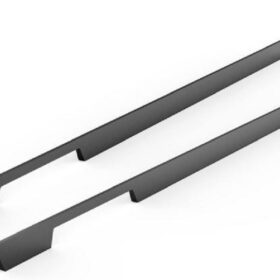How to Choose the Right Concealed Profile Handle for Your Project
Concealed profile handles are an excellent way to add a touch of sophistication and modernity to any project. They are designed to be hidden within the profile of your door or drawer, leaving only a slim, linear indentation. This sleek and minimalist look has been popular in contemporary architecture and interior design, and it’s a great way to create a seamless and refined aesthetic. Choosing the right concealed profile handle can be a challenge, but it’s important to consider several factors before making a decision.
Material
Durability and aesthetics are key when it comes to your concealed profile handles.
Aluminum
Lightweight, rust-resistant, sturdy. Comes in various anodized finishes for color options.
Stainless Steel
Corrosion-resistant, strong, and comes in different grades and finishes, like brushed or polished.
Zinc Alloy
Strong and relatively inexpensive, but may not be as resistant to wear and tear as other materials.
Finish
Consider the color and texture of the finish to match your project’s style.
Matte
A softer, less reflective finish that can give a modern and understated look.
Glossy
A shiny, reflective finish that can add a touch of glamor or sophistication to a space.
Brushed
A textured finish that hides fingerprints and scratches, making it a good choice for high-traffic areas.
Shape and Style
Choose a shape that complements the design of your project.
Linear
A straight, horizontal or vertical line for a clean and minimalistic look.
Curved
A gentle curve that can add a touch of elegance or soften the look of a space.
Customized
If you want a truly unique look, consider customizing the shape of your profile handle to match your design vision.
Length
The optimal length of the profile handle will depend on the size of the door or drawer it will be used on.
Short
Less than 10 inches (25 cm), suitable for small doors or drawers.
Medium
Between 10 and 20 inches (25-50 cm), suitable for most standard doors and drawers.
Long
Over 20 inches (50 cm), suitable for large doors or drawers, such as sliding doors or cabinets.
Installation
Consider the ease and cost of installation.
Surface Mount
Installed on the surface of the door or drawer, easy to install but may not be as secure.
Recessed Mount
Installed within the profile of the door or drawer, requiring precise cutting and more complex installation.
Screw-On
Uses screws or bolts to attach to the door or drawer, a relatively straightforward installation method.
Adhesive
Uses adhesive to attach to the door or drawer, requiring no drilling or cutting but may have limited durability.
-
2024-11-29Top Trends in Modern Kitchen Cabinet Pulls for 2024
-
2024-11-28The Ultimate Guide to Modern Kitchen Cabinet Pulls- Materials, Styles, and Tips
-
2024-11-27Elevate Your Kitchen Design with These Must-Have Modern Cabinet Pulls
-
2024-11-26Sleek and Stylish- The Best Modern Kitchen Cabinet Pulls for a Contemporary Look










